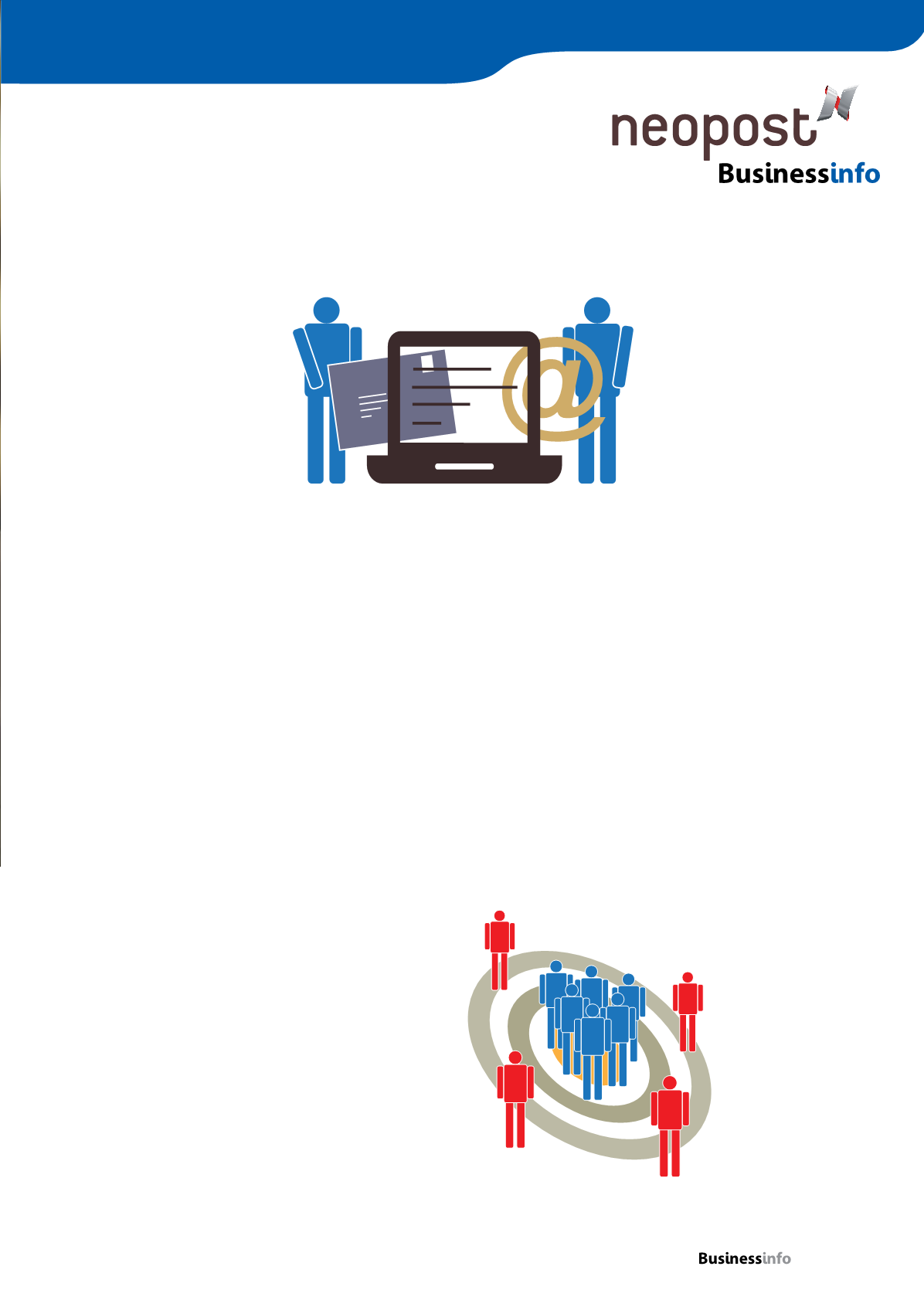
Mailing Survey
Mixed messages
Business Info
readers are digitising key
business processes, including customer
communications, but are doing so in
an ad hoc manner and are therefore
unlikely to be maximising the benefits
of their investment in the latest
technology, a new survey shows.
The
Business Info
/Neopost Mailing
Survey Questionnaire 2014 carried in
Issue 113 underlines the extent to which
readers have already introduced paperless
workflows for key business processes.
More than four out of five (81%)
said that their invoicing was already
either 100% digital or digital by default.
Other processes that readers are making
paper-free include payment (36%);
marketing (36%); sales orders (27%); bills
& statements (27%); expenses (27%);
customer support (27%); and brochures
(27%).
Worryingly, almost two thirds (62%)
of respondents said the transition from
paper-based workflows to electronic
processes was happening in an unplanned
manner.
Lack of strategy
This is not the only area of respondents’
operations that would benefit from
greater direction. So, too, would
communications in general and mailing
in particular. Currently, more than three
quarters (77%) of survey respondents
have neither a postal budget nor a
strategy to improve the cost-effectiveness
of their communications.
The risk is that without strategic
oversight, organisations won’t reap all the
benefits of a digitisation strategy and, in
the worst cases, could end up damaging
their communications effectiveness.
Digitisation drivers
Amongst the 38% of respondents that do
have a plan to manage the switch from
hard copy to digital communications,
the main motivation for doing so is to
save money on print and postage. This
was considered to be marginally more
important than reducing the amount of
paper in an organisation, shrinking its
carbon footprint or speeding up processes.
A lesser consideration, deemed only
‘quite important’ by 80% of customers,
is the use of digital channels to meet
the communication preferences
of customers. That said, customer
preference is still a factor for just under
half (46%) of organisations when
deciding whether to use digital or hard
copy communications, compared to just
over 60% who base their decision on
cost and speed.
Bigger budgets
When it comes to postal
communications,
Business Info
readers
appear to be bucking the trend for
reduced budgets. Only one in four survey
respondents has cut postal budgets
in the last 18 months. Over the same
period an equal number has increased
postal budgets.
Looking ahead, 36% of respondents
say they expect budgets either to stay
the same or to rise in the next 18
months, compared to 27% who expect
them to shrink.
There are a number of
possible reasons why there is
less impetus in SMEs to cut
costs: the fact that most
lack a communications
strategy suggests there is
less management pressure
to identify and implement
cost savings; and the cost of
postal communications may
be less of a factor in SMEs
with smaller customer bases.
Stable mail volumes
Another reason might be
that many smaller businesses
have already substituted
much of their physical mail with
electronic communications. In 50% of
organisations, mail now accounts for less
Business Info
/Neopost Mailing Survey Questionnaire 2014
Small and medium-sized businesses need to think more strategically
about mail if they are to maximise the benefits of digitisation
than 25% of outbound communications,
compared to a quarter of organisations
18 months ago.
Overall,
Business Info
readers don’t
expect any further reduction in mail
volumes over the next 18 months. In fact,
there are signs that mail as a proportion
of total outbound communications could
increase: 34% of respondents believe
that in 18 months’ time 50% or more
of their outbound communications will
be in paper form.When asked about
the situation 18 months ago, less
than a quarter (23%) thought paper
communications made up a majority of
their total communications volume.
The picture is different for inbound
communications, where there is a clear
downward trend. The proportion of SMEs
in which paper makes up less than 25%
of total inbound communications has
risen from 25% 18 months ago to 42%
today, with a predicted rise to 58% 18
months from now.
Changing attitudes
Stable outbound mail volumes underline
the continuing importance of paper-
based communications. Although
electronic media are widely perceived
to be cheaper and more efficient than
paper-based communications, physical
mail still has attractive qualities.
Two thirds of respondents
agree or strongly agree that postal
communications are better targeted than
digital communications; and almost six
out of 10 believe postal communications
are more effective and more memorable
than digital media.
Seven out of 10 respondents prefer
to use the post when communicating
confidential or sensitive information
and 60% use the post when
proof of delivery is required.
Other supposed
advantages of paper are less
clear-cut: respondents are
split equally on whether
postal communications
are more trusted, more
secure or more authoritative
than digital media. Only a
minority – 33%, 27% and 25%
respectively – believe postal
communications are preferred by
customers, more reliable and better
value than digital media.
Continued...
Neopost provides
solutions that
enable customers
to integrate their
postal and digital
communications.
Two thirds of
respondents to
the
Business Info
/
Neopost survey
believe postal
communications
are better targeted.
magazine
01732 759725
33


